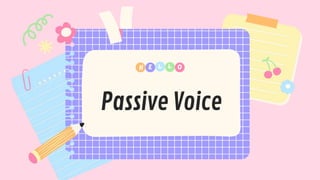
Passive voice ppt.pptx
- 2. When to Use Passive Voice? - you don't want to say who or what did the action - - you don't know who did the action - - The object is the most important part of the sentence If we want to show the person or thing doing the action, we use by: She was attacked by a dangerous dog. The money was stolen by her husband.
- 3. How to make the Passive in English We make the passive by putting the verb 'to be' into whatever tense we need and then adding the past participle. For regular verbs, we make the past participle by adding 'ed' to the infinitive. So play becomes played
- 4. In a passive sentence, the object of an active sentence becomes the subject. Then we have to use the verb be in the tense we need and add the past participle of the main verb after it. In a passive sentence, the subject is the receiver of the action, not the doer of the action.
- 5. Structure to form passive voice in past simple Was/ Were + past participle + S Let’s practice My uncle made these chairs.
- 6. Object + Was/ Were + being + participle + S. Mary was cleaning the room. (Singular) The room was being cleaned by Mary. Mary was cleaning the rooms. (Plural) The rooms were being cleaned by Mary.
- 7. Exercise
- 8. Object + had been + participle Example: The girl had eaten the bread. (Active) The bread had been eaten by the girl. We write phrases in active voice from the past perfect when we want to focus on the person / people who have performed an action in the past before another action or time. Structure to form past p into passive voice
- 9. Examples
- 10. 3. I had paid the money. (focusing on the doer of the action) Put the following sentences into passive voice. (past perfect passive) 1. Dr. Richard had saved Silvia's life. 2. The Americans had discovered another planet. • Passive: •Silvia's life had been saved by Dr. Richar. •2. Another planet had been discovered by Americans •The money had been paid (by me). (focusing on the object that the action was acted upon ‘The money)
- 11. Active voice: Is one in which the subject who practices the action is evidenced. Passive voice: Here who is in evidence is the subject who receives the action.
- 12. Active voice. • Subject+ verb+object Example. My brother studies the lesson. Passive voice. • Sobject+ is or are+past participle+ prepotition (by)+subject who performed the action. Example. The lesson is studied by my brother.
- 13. In the active voice of the Present Continuous, we focus on the person who is currently performing an action in the present. In the passive voice of the present continuous, we focus on the object (the receiver of the action) that is receiving the action in the present. The verb tense is formed using “is/am/are + being + V3”.
- 14. Examples: Active voice sobject+ is/am/are+VI+ing+object. • She is taking a class. (she=oder of the action,is=helping verb=taking=main verb,a class= receiver of action) Passive voice. The object(receiver of the action)+(is/are/am)+being+V3+(by the doer) • A class is being taken by her. (A class=the new subject,is being=helping verb,taking=main verb)
- 15. In the present perfect tense, we talk about completed actions, just to give the action update, or to talk about our life experiences. In the active voice of the present perfect, we talk about what someone has finished. The focus is on the action author who has completed an action. But in the passive voice of the present perfect tense, we speak of what has been completed or finished; who has finished it is not important in the passive voice of the present perfect tense.
- 16. Examples: Active voice. Object +have/has+past participle+object. • She has cooked the food. Passive voice. Object+has/heve+been+past participle+by +subject. • The food has been cooked by her
- 17. The passive verb form in the simple future tense is made by putting will / shall + be before the past participle form of the verb. Active form: will/shall + first form of the verb Passive form: will/shall + be + past participle form of the verb
- 18. Examples: Active voice: She will accept the offer. Passive voice: The offer will be accepted by her. Active voice: You will never forget this lesson. Passive voice: This lesson will never be forgotten by you.
- 19. The passive verb form in the future perfect tense is made by putting: Active verb form: will/shall + have + past participle form of the verb Passive verb form: will/shall + have been + past participle form of the verb
- 20. Examples: Active voice: I will have finished the job by Monday. Passive voice: The job will have been finished (by me) by Monday. Active voice: Rahul will have brought the violin. Passive voice: The violin will have been brought by Rahul.
- 21. How to use Modal Verbs in the Passive Voice? We use Modal Verbs-verbs like can, could, must, and should- to talk about things such as ability, possibility, permission, or obligation. And we use passive voice to focus on the object of an action rather than the doer of the action
- 22. Modal + be + Past participle Example : You should fix your computer (active) Your computer should be fixed (passive)
- 23. Structure Modal + have been + past participle Example: It could have been done . Her writing should have been fixed.
- 24. Must have been We often use this modal structure to guess about something that might have happened (not for obligation) Example: Your trip to Colombia must have been exiting!